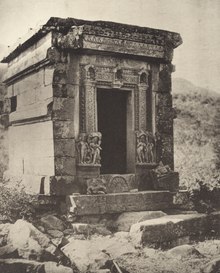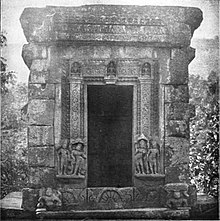Pataini temple
| Pataini temple | |
|---|---|
 Pataini devi temple | |
| Religion | |
| Affiliation | Jainism |
| Deity | Pataini Devi |
| Location | |
| Location | Unchehara, Satna district, Madhya Pradesh |
| Geographic coordinates | 24°26′18.1″N 80°46′32″E / 24.438361°N 80.77556°E |
| Architecture | |
| Style | Gupta architecture |
| Date established | 5th century |
The Pataini temple or Pataini devi temple is a 5th century Jain temple constructed during the reign of the Gupta Empire and located near the town of Unchehara in Madhya Pradesh, India.
Location
The Pataini temple is located on Satna-Unchehara riad, 12.87 kilometres (8.00 mi) north of Unchehara.[1][2]
History
Discovered by Alexander Cunningham in 1873-74,[2] the Pataini temple dates back to the Gupta Empire. The temple houses a 10th or 11th century inscription detailing the name of the residing deities.[3] The temple is wedged out 0.3 metres (1 ft 0 in) from the back wall corner, indicating an attempt was made to pull down the temple, which was possibly interrupted by villagers.[4]
Architecture

The temple is a small 2.08 by 1.98 metres (6 ft 10 in by 6 ft 6 in) structure notable for its massive Gupta style, single flat slab, 2.34 by 2.24 metres (7 ft 8 in by 7 ft 4 in) roof.[note 1][6][1][5][3][7] The temple entrance features an ornate door frame and two mouldings, another common feature of Gupta architecture.[8]
The temple enshrines a 1.07 metres (3 ft 6 in) idol of Jain goddess Devi flanked by two male figures inside a small mandapa.[9][2] The idol originially had four arms and is now unrecognizable.[2]
The idol is surrounded by small figures - 5 above, 7 to the right and left, and 4 below. Above these figures, carvings of Tirthankara in lotus position, with the image of Neminatha seated on a pedestal with the shankha, are displayed.

According to the inscription, the figures are named as follows:[1][10]
| S. No. | Above | Left | Right |
|---|---|---|---|
| 1 | Bahurupini | Aparajita | Jaya |
| 2 | Chamunda | Mahamunusi | Anantamati |
| 3 | Padmavati | Anantamati | Vairata |
| 4 | Vijaya | Gandhari | Gauri |
| 5 | Saraswati | Mansai | Kali |
| 6 | Jwalamalini | Mahakali | |
| 7 | Manuji | Vrijamsakala |
The outer doorway shows three figures, Rishabhanatha, Suparshvanatha, and Parshvanatha. Carvings of Shiva and Parvati are shown underneath the images of Trithankara. The bottom of the door contains images of Yamuna, Ganga, and their attendants.[2]
See also
Notes
References
Citation
- ^ a b c Cunningham 1879, p. 31.
- ^ a b c d e Archaeological Survey of India 1921, p. 108.
- ^ a b "General view of the Jain Temple of Pataini Devi, Pithaora". British Library. Retrieved 2 July 2022.
- ^ Cunningham 1879, p. 33.
- ^ a b Datta & Beynon 2016, p. 49.
- ^ Royal Asiatic Society of Great Britain and Ireland 1881, p. 36.
- ^ Rawlinson 1881, p. 36.
- ^ Cunningham 1879, p. 32.
- ^ Beglar 1878, p. 28.
- ^ Archaeological Survey of India 1921, pp. 108–109.
Sources
- Archaeological Survey of India (1921). Progress Report of Archaeological Survey of India Western Circle (PDF). Baptist Mission Press.
- Beglar, J. D. (1878). Report of a Tour in the Bengal Provinces in 1872-73. Archaeological Survey of India. Vol. 8. Office of the Superintendent of Government Printing.
- Cunningham, Alexander (1879). Report of a Tour in the Central Provinces in 1873-74 and 1874-75. Archaeological Survey of India. Vol. 9. Office of the Superintendent of Government Printing.
- Datta, Sambit; Beynon, David (2016). Digital Archetypes: Adaptations of Early Temple Architecture in South and Southeast Asia. Routledge. ISBN 9781317150947.
- Rawlinson, H. C. (1881). "Royal Asiatic Society. Proceedings of the Fifty-Eighth Anniversary Meeting of the Society". Royal Asiatic Society of Great Britain and Ireland. 13 (1): 1–136. JSTOR 25196867.
- Royal Asiatic Society of Great Britain and Ireland (1881). Journal of the Royal Asiatic Society of Great Britain and Ireland. Cambridge University Press.
External links
![]() Media related to Pataini temple at Wikimedia Commons
Media related to Pataini temple at Wikimedia Commons
